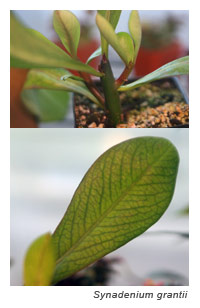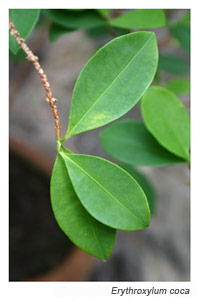This is Not Coca
Comments on a plant passed off as coca with discussion of lime and lye
v1.1 - Aug 10, 2010
Originally published in ER
Citation: Trout K. "'This is Not Coca' with discussion of lime and lye". The Entheogen Review. Winter 2006;15(4):123 and 137-138. Online edition: Erowid.org/plants/coca/coca_article1.shtml

|
This remark alone should be enough to hip readers that something was amiss, as lime (the chemical/mineral) not "limes" (the citrus fruit) is used when chewing coca leaf (see "Lime and Lye" below for more discussion of lime). However, the plant itself provides ready evidence that it is not coca. It has large succulent leaves, green stems, and an abundant milky white latex that is reported to cause a burning sensation when placed in the mouth. All of these features are lacking in Erythroxylum species.
A few years ago this same plant was being passed around in ethnobotanical circles, variously "identified" as Erythroxylum coca (cocaine-containing), or E. catuaba (medicinal but non-cocaine-containing), or as some other unknown form of coca. In all but one instance I have encountered, the plant was said to have been obtained from a knowledgeable source with whom the current grower had lost touch.
The plant is positively identified as a member of the Euphorbiaceae; it is a commonly cultivated plant known as Synadenium grantii. There are several color forms of this plant in cultivation, but the "green-leaf form" is the correct ID for the ersatz-coca. Its leaves are somewhat fleshy and 3-7 inches long, while coca's leaves are not at all fleshy and are only up to 2.5 inches long. S. grantii is generally regarded in horticulture to be a poisonous plant with caustic latex. In some cases it has been said to actually cause burns or contact dermatitis.
I know a disturbing number of people who have complained about trying to get psychoactive effects from this plant and only burning their mouth. Some have repeatedly tried, unsuccessfully, to achieve effects (an approach that might exemplify one of the minor driving forces in Darwinian evolution). One person commented that taking it orally produced an 'uncocaine-like' stimulation lasting ten hours, but this bioassay report presently stands alone. It is suggested that people do not consume this or any other members of the Euphorbiaceae unless they have some proof of their safety.

|
Lime and Lye #
I'm wondering about plants that people often chew in conjunction with lime; I don't have any questions about the plants, but rather about the use of lime. I know that lye can be created from lime, and that just about any commercially available powdered lime carries a label stating that it can cause severe burns if in contact with skin and eyes. Do you have any knowledge about this? Can one use any type of lime? How careful does one need to be when putting something in their mouth where its label says it can burn them? Thanks for any thoughts on this.-- P.H., NMCertainly one way of making lye (sodium hydroxide) is to react sodium carbonate and calcium hydroxide. Pure calcium hydroxide and calcium oxide will both burn you if you get them on you and just leave them there--especially if you've made a paste; think of getting wet cement on you and not washing it off. Lye can burn you even worse, though, so it would be a bad choice of a base. Something food grade is better than cement-making materials if intended for human ingestion, of course.
Not all acids and bases are equal. For instance, someone can put vinegar in his or her mouth and be unharmed, but concentrated glacial acetic acid would burn this person badly. Lime is less caustic than lye, although it would still burn you if you stuck a mass of freshly prepared lime in your mouth and left it there. The plants it is mixed with help to neutralize it. Plant alkaloids can balance the alkali if they are carefully mixed, such titration as practiced by indigenous people is a fine art. Most people progressively add tiny bits, using the taste to judge when the right amount has been added; the taste shifts from bitter to sweet.
What people refer to as lime is usually made from burning a calcium carbonate source such as snail shells or limestone, or from burning plants to create a basic ash that is then extracted by leaching the ashes, and then concentrating the water to dryness. Burning limestone or snail shells creates calcium oxide (aka quicklime). Quicklime wants to absorb water from the air, and does so rapidly, forming calcium hydroxide (aka slaked lime). Calcium hydroxide likes to absorb CO2 from the air to become calcium carbonate. The more calcium carbonate that is present, the less likely it is to burn you and the less effective it is at liberating alkaloid--this simply means that more is required, not that it can not work. Baking soda can be effective, and it is also less basic so it's a safe choice. Some people take pure cocaine, mix it with baking soda, and place a bit of this between cheek and gum for similar effects.
While baking soda won't burn you, quicklime and slaked lime can. Simply touching lime is not a problem. Dump a wad of it into your mouth and leave it there on its own, and it can burn you--especially if freshly prepared. There is an approach, widely discussed in ethnobotanical/anthropological literature that may be pertinent concerning human use of strong lime. Some traditional South American coca chewers use a stick to apply small bits of lime onto the center of the quid as needed. It is never transferred directly onto the mouth, due to its ability to burn. They often use very strong lime, so where they are positioning it in the quid might be the key to safe use of strongly basic lime materials. In any case, not overdoing the base is more important than the specific choice.
The alkali lime liberates the organic acids in the leaf, or the salts one encounters in purified preparations, into their free-base form, so that they are more efficiently absorbed through the mucosal tissues of the mouth. It only requires enough alkali to do the conversion, so small bits get repeatedly added to the quid until the alkaloid contained within it has been chewed out. The stronger the alkali chosen (within reason) the less that needs to be used, and the more care needs to be used in applying it to the mouth. Really strong bases like lye should never be used for this purpose.
On the topic of lime, it is worth mentioning the surprisingly widespread misconception that citrus limes are used. Although we have not seen it, we have even heard that this idea has been repeated in a documentary that touches on the preparation of coca leaf quids. Since citrus limes are acidic, rather than basic, they are the exact opposite of what someone chewing coca would want to augment his or her chew. -- Keeper Trout
Photo Credits #
- Synadenium grantii plant. Photos by Keeper Trout. 2006.
- Erythroxylum coca plant. Photo by Zariat. 2006.


